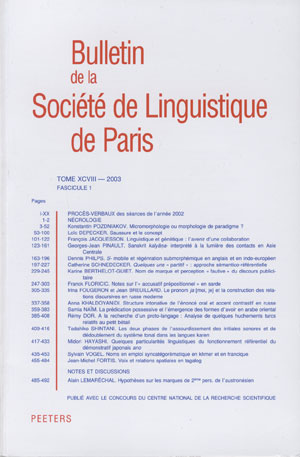 previous article in this issue previous article in this issue | next article in this issue  |

|
Document Details : Title: Métaphorisation et création morphologique Author(s): LAGERQVIST, Hans Journal: Bulletin de la Société de Linguistique de Paris Volume: 111 Issue: 1 Date: 2016 Pages: 213-241 DOI: 10.2143/BSL.111.1.3197368 Abstract : Partant de considérations sur la formation du pluriel de la souris outil périphérique de l’ordinateur en suédois et en anglais, mus et mouse, j’attire dans cet article l’attention sur le rôle joué par la métaphore dans l’innovation morphologique nominale. A l’aide d’une définition de la métaphore fondée sur l’anisosémie et l’analyse sémique, je tâche de montrer (1) que la métaphorisation peut aboutir à une réfection totale du substantif, au moyen, par exemple, d’affixes, mais (2) qu’elle ne modifie souvent que le pluriel qui est alors pourvu de deux formes, dont l’une métaphorisée. D’autre part, (3) il arrive que la métaphorisation n’exerce aucune influence innovatrice sur le nom qui reste morphologiquement tel quel. Là où les innovations font partiellement ou entièrement défaut, autrement dit, parmi les noms appartenant aux catégories (2-3), je cherche à trouver les causes qui sous-tendent cette carence, entre autres dans l’insuffisance des moyens morphologiques disponibles. Dans les mêmes catégories, rejetant l’interprétation polysémique, je tire la conclusion qu’il y a homonymie au singulier et, pour ce qui est de la troisième catégorie, également au pluriel. Les exemples de morphologie métaphorisée que je discute ont été empruntés à une gamme de langues européennes, mais aussi à l’arabe. Je joins à l’article une Annexe résumant les noms étudiés. After a preliminary discussion of the plural of Swedish mus and English mouse, denoting a device for personal computers, I draw attention in this article to the importance of the metaphor in nominal morphological innovation, defining the metaphor in terms of 'anisosemy' a phenomenon which involves the activation of selection restrictions and a renewal of the semantic components. Using this analysis of the metaphor, I endeavour to show (1) that metaphorisation can lead to the total remaking of a noun with the help of affixes, for example, but (2) that in many cases it only affects the plural, which is then endowed with two forms, as Swedish möss, musar (in the singular mus) and English mice, mouses (in the singular mouse). On the other hand, (3) metaphorisation often has no morphological influence on the noun, which then remains as it was. In cases where innovations lack, totally or partially, i.e. in categories (2-3), I search for an explanation for this absence, inter alia in the deficiency of the morphological means available. For the same two categories, I reject a polysemic interpretation and conclude that there is homonymy in the singular and, as far as the last category is concerned, also in the plural. The examples I present of metaphoric morphology come from several European languages and also from Arabic. At the end of the article, I append a list of the nouns studied. |
|
